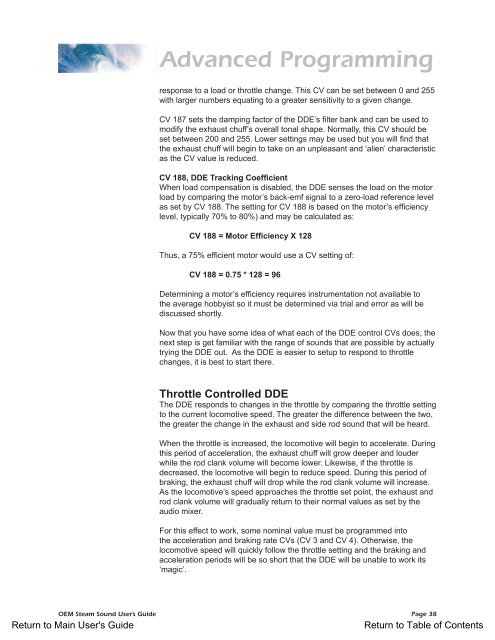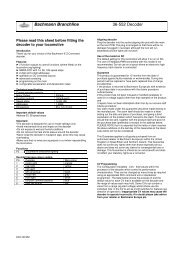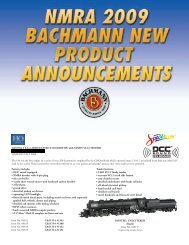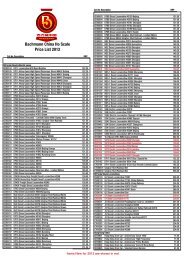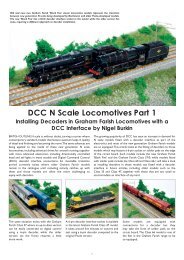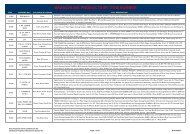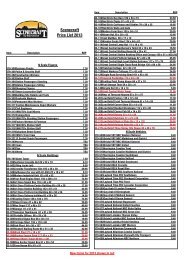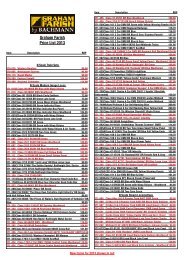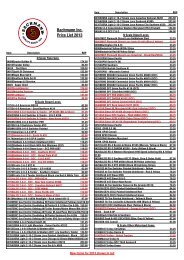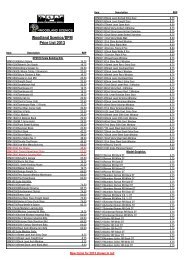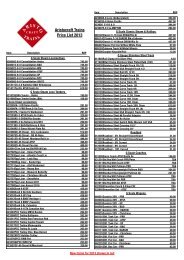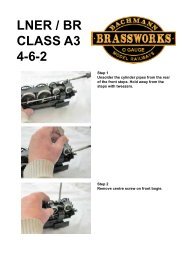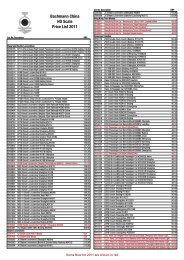Spectrum Steam Sound User Guide(1.4MB) - Bachmann
Spectrum Steam Sound User Guide(1.4MB) - Bachmann
Spectrum Steam Sound User Guide(1.4MB) - Bachmann
You also want an ePaper? Increase the reach of your titles
YUMPU automatically turns print PDFs into web optimized ePapers that Google loves.
Advanced Programmingresponse to a load or throttle change. This CV can be set between 0 and 255with larger numbers equating to a greater sensitivity to a given change.CV 187 sets the damping factor of the DDE’s filter bank and can be used tomodify the exhaust chuff’s overall tonal shape. Normally, this CV should beset between 200 and 255. Lower settings may be used but you will find thatthe exhaust chuff will begin to take on an unpleasant and ‘alien’ characteristicas the CV value is reduced.CV 188, DDE Tracking CoefficientWhen load compensation is disabled, the DDE senses the load on the motorload by comparing the motor’s back-emf signal to a zero-load reference levelas set by CV 188. The setting for CV 188 is based on the motor’s efficiencylevel, typically 70% to 80%) and may be calculated as:CV 188 = Motor Efficiency X 128Thus, a 75% efficient motor would use a CV setting of:CV 188 = 0.75 * 128 = 96Determining a motor’s efficiency requires instrumentation not available tothe average hobbyist so it must be determined via trial and error as will bediscussed shortly.Now that you have some idea of what each of the DDE control CVs does, thenext step is get familiar with the range of sounds that are possible by actuallytrying the DDE out. As the DDE is easier to setup to respond to throttlechanges, it is best to start there.Throttle Controlled DDEThe DDE responds to changes in the throttle by comparing the throttle settingto the current locomotive speed. The greater the difference between the two,the greater the change in the exhaust and side rod sound that will be heard.When the throttle is increased, the locomotive will begin to accelerate. Duringthis period of acceleration, the exhaust chuff will grow deeper and louderwhile the rod clank volume will become lower. Likewise, if the throttle isdecreased, the locomotive will begin to reduce speed. During this period ofbraking, the exhaust chuff will drop while the rod clank volume will increase.As the locomotive’s speed approaches the throttle set point, the exhaust androd clank volume will gradually return to their normal values as set by theaudio mixer.For this effect to work, some nominal value must be programmed intothe acceleration and braking rate CVs (CV 3 and CV 4). Otherwise, thelocomotive speed will quickly follow the throttle setting and the braking andacceleration periods will be so short that the DDE will be unable to work its‘magic’.OEM <strong>Steam</strong> <strong>Sound</strong> <strong>User</strong>’s <strong>Guide</strong> Page 38Return to Main <strong>User</strong>'s <strong>Guide</strong>Return to Table of Contents


